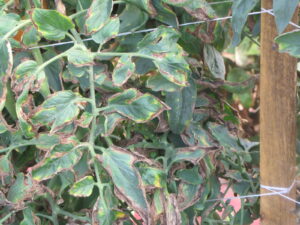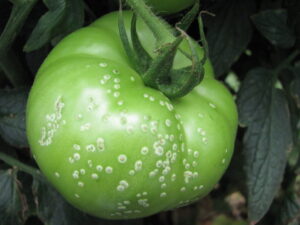In the Midwest, three major bacterial diseases threaten tomato production. These diseases are bacterial canker, bacterial spot and bacterial speck. Although these diseases are all caused by bacteria, they vary in symptomology, biology and management options. We will discuss symptoms, biology and management of the three bacterial diseases in a series of newsletter articles. This article focuses on Bacterial canker.
Bacterial canker can cause a severe wilt and decline of tomato plants. However, the symptoms for this disease vary widely.
Often the initial symptom observed in field tomatoes is the chlorotic and necrotic margins of leaves (Figure 1). The band of necrotic tissue on the leaf edge may increase with time, enveloping most or all the leaf. Another common symptom is a wilt and general decline of tomato plants. A brown canker may be observed along the stem. Vascular tissue may become brown and streaked. Finally, lesions may develop on the fruit. These lesions may be a light scabby brown with white halos and are often called bird’s eye spots (Figure 2).
The bacterial pathogen that causes bacterial canker can become systemic in the tomato plant. That is, the bacterium, once inside the tomato plant, can move in the vascular tissue. This is an important difference between bacterial canker and bacterial spot and speck. The bacteria that cause the latter two diseases cause lesions on the surface of the plant and will not move inside the plant.
If the bacterial canker pathogen occurs in a transplant greenhouse, the pathogen may enter the plant. From that point, the bacteria are inside the plant; symptoms may continue to increase in severity over time. Unfortunately, symptoms of bacterial canker on tomato transplants may not be obvious. However, if these plants are moved into a greenhouse or field production situation, the disease moves with them. Therefore, it is important to manage bacterial canker in the transplant greenhouse.
The bacterium which causes bacterial canker of tomato may survive in seed, crop debris, volunteer tomatoes and equipment such as wooden stakes. Use only new or sterilized planting stakes, transplant trays and other planting equipment. The most important factor in managing bacterial canker of tomato is to avoid seed contaminated with the pathogen or transplants that have symptoms. The bacterial canker pathogen will survive for 3-4 years in crop residue. So, crop rotation and fall tillage are a necessary part of disease management. Above, it was discussed how the bacterial canker pathogen can be systemic in the plant. This limits management options. Applications of a copper compound may limit the spread of the disease between plants in the field. However, copper applications will not affect bacteria inside the plant. Unfortunately, it is possible that bacterial canker has spread widely inside the transplant greenhouse. Since transplants are overhead watered regularly, spread is very possible. Finally, bacterial canker can be seed borne or arrive on transplants. Purchase seed that has been tested for bacterial canker and inspect transplants upon delivery or scout your transplant house regularly for symptoms.
The severity of bacterial canker depends in part on when the plant is affected. If transplants are infected, the disease is likely to be quite severe. If the disease affected plants after first fruit, then the disease may not be severe until late in the season. It is important to either avoid bacterial canker in your operations or delay the disease as much as possible.
For more information about bacterial canker of tomato including managing the disease on transplants, see this article in the Vegetable Crops Hotline.
We will discuss bacterial spot and speck in the next issues of the newsletter.

